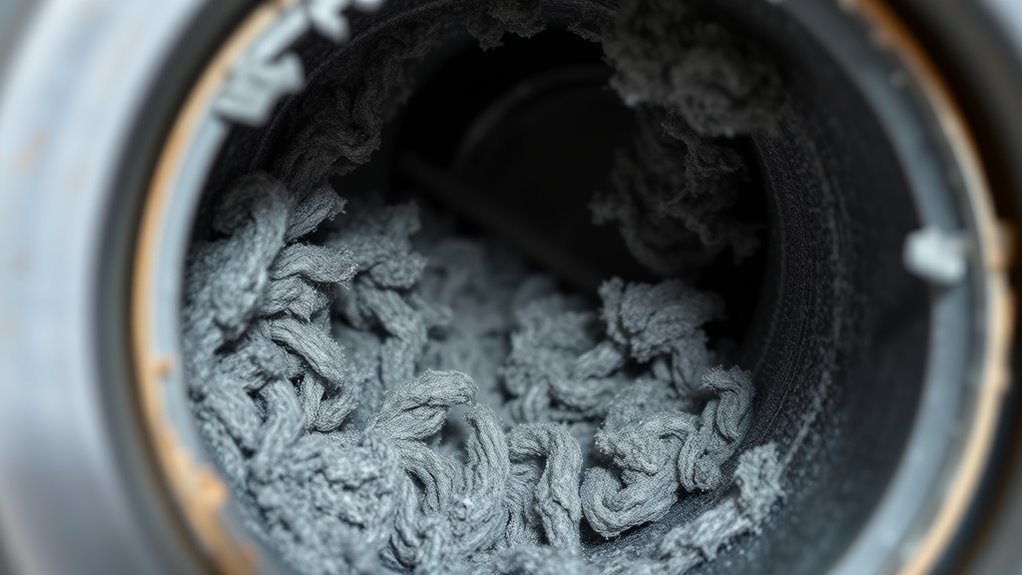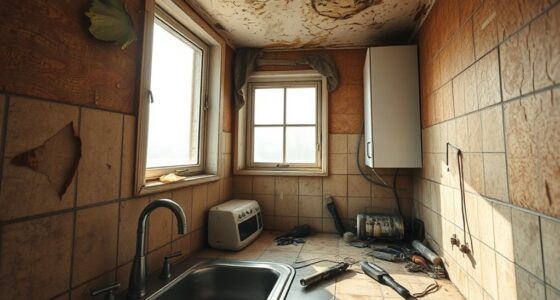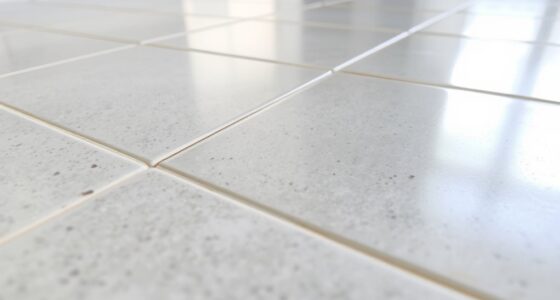Lint buildup in your dryer vent is a serious fire hazard that many overlook. Over time, lint restricts airflow, causes your dryer to overheat, and increases the risk of sparks igniting a blaze. Regularly cleaning your vent, at least once a year, can prevent these dangers, keep your appliance running efficiently, and save you from costly fires. Want to know more about how to protect your home from lurking fire risks? Keep going to learn essential safety tips.
Key Takeaways
- Lint buildup creates airflow restrictions, causing dryer overheating and increasing fire risk.
- Lint is highly combustible and can ignite easily if not regularly removed.
- Neglecting vent cleaning is a leading cause of household dryer fires.
- Signs like longer drying times and excessive heat indicate potential fire hazards.
- Annual vent cleaning significantly reduces fire risk and enhances dryer safety and efficiency.

Have you ever considered how often you should clean your dryer vent? Many homeowners overlook this essential maintenance task, but it’s vital for safety and efficiency. Over time, lint buildup accumulates inside the vent, creating a serious fire hazard. When lint collects, it restricts airflow, making your dryer work harder and longer to dry clothes. This not only wastes energy but also raises the risk of overheating and potential fires. Understanding the importance of regular dryer vent cleaning can save you money and, more importantly, protect your home.
Regularly cleaning your dryer vent prevents fire hazards and improves efficiency.
Lint buildup occurs naturally as your dryer operates. Every load releases tiny fibers that escape into the vent system. If you don’t clean the vent regularly, these fibers amass into a thick layer of lint. This layer clogs the airflow pathway, turning your vent into a choke point. As airflow restriction worsens, your dryer’s temperature rises, and it may shut off prematurely or continue running longer than necessary. Over time, this inefficiency increases your utility bills and accelerates wear and tear on your appliance. Additionally, attention to maintenance is crucial because neglecting it can lead to significant safety hazards.
The real danger lies in how easily lint can ignite. Lint is highly combustible, and when combined with heat generated inside the dryer, it becomes a fire risk. A blocked vent causes the dryer to overheat, increasing the chance of sparks igniting the lint. According to fire safety experts, failure to clean dryer vents is a leading cause of household fires, with thousands occurring annually. The damage can be devastating, and the resulting costs—both financial and emotional—are often avoidable with simple maintenance.
Cleaning your dryer vent isn’t complicated, but it requires regular attention. Experts recommend inspecting and cleaning the vent at least once a year, but if you notice longer drying times, a hotter dryer, or musty smells, it’s a sign that lint buildup is already a problem. You can perform some cleaning yourself using a vent brush or vacuum attachment, but professional cleaning might be necessary for thorough removal, especially if the vent runs a long distance or has complicated bends. Regular maintenance keeps airflow unrestricted, reducing fire risk, improving dryer performance, and extending the life of your appliance.
Frequently Asked Questions
How Often Should I Replace My Dryer Vent?
You should replace your dryer vent if it’s made from flimsy or outdated vent material, such as vinyl, which can pose fire hazards. Typically, you’ll want to substitute your vent every 5 to 10 years, especially if your vent installation shows signs of damage or excessive lint buildup. Regularly inspecting your vent guarantees it stays safe and efficient, reducing the risk of fire and improving dryer performance.
Can I Clean the Vent Myself Safely?
Think of your dryer vent as a hidden pathway that needs regular TLC. You can definitely tackle vent cleaning yourself, but prioritize DIY safety. Use proper vent cleaning tools designed for the job, and always unplug your dryer first. Don’t rush—carefully clear lint buildup to prevent fire hazards. If you feel unsure, calling in a professional guarantees the job’s done right, keeping your home safe and your dryer running smoothly.
What Signs Indicate a Clogged Dryer Vent?
You can tell if your dryer vent is clogged by watching for signs like longer drying times and increased energy bills. Lint buildup causes airflow restriction, making your dryer work harder. If your clothes are still damp after a full cycle or the vent area feels hot, these are clear signs of a blocked vent. Regularly inspecting and cleaning your vent helps prevent fire hazards caused by lint buildup.
Are Professional Vent Cleaning Services Worth the Cost?
Did you know that the National Fire Protection Association reports nearly 2,900 home fires annually due to dryer vents? When considering if professional vent cleaning services are worth the cost, do a cost-benefit analysis focusing on safety considerations. While it might seem like an expense, investing in expert cleaning reduces fire risk, saves energy, and prolongs your dryer’s lifespan, making it a smart, safe choice in the long run.
Does Vent Cleaning Improve Dryer Efficiency?
You might wonder if vent cleaning improves dryer efficiency. The answer is yes. When you clean your vents, you boost vent airflow, which helps your dryer operate more effectively. This reduces drying time, saving you energy and effort. Regular vent cleaning prevents lint buildup that can block airflow and cause longer drying cycles. So, keeping your vents clean keeps your dryer running smoothly and efficiently, making your laundry routine faster and more cost-effective.
Conclusion
Regularly cleaning your dryer vent isn’t just about efficiency — it’s about safety. Think of lint as the sneaky villain, hiding behind your walls, waiting for the right moment to spark a fire. When you clear out that buildup, it’s like removing a ticking time bomb from your home. So, take a moment, check those vents, and keep your family safe. A simple habit today can prevent a devastating fire tomorrow.









